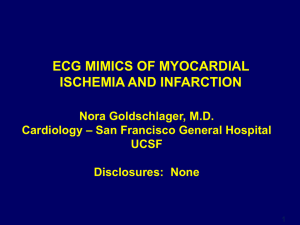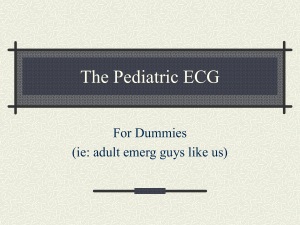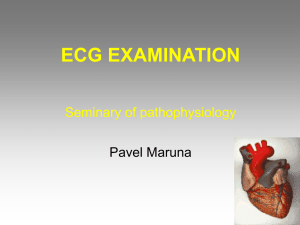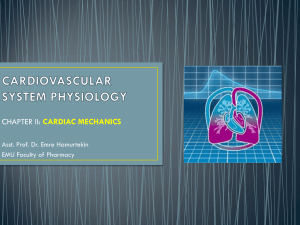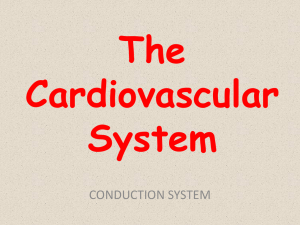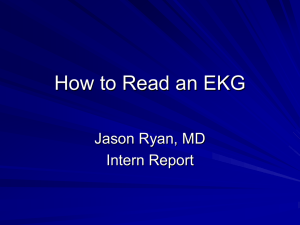Electrocardiogram
advertisement
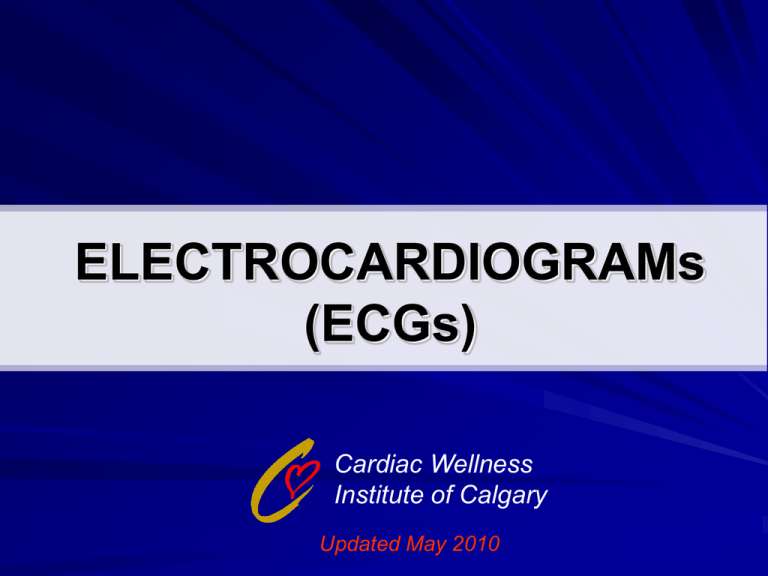
ELECTROCARDIOGRAMs (ECGs) Cardiac Wellness Institute of Calgary Updated May 2010 Material to be Covered − ACSM’s Resource Manual for Guidelines for Exercise Testing and Prescription (6th ed.) − Chapter 27 − Rapid Interpretation of EKG’s (6th ed.) LEAD PLACEMENT Standard 12-lead ECG: • Limb Leads - 6 in all - I, II, III, aVL, aVR, aVF • Chest leads - 6 in all -V1,V2,V3,V4,V5,V6 LIMB LEADS Bipolar - Augmented - - + + I + III aVR + + II + aVF aVL CHEST LEADS Along the horizontal plane: • V1 and V2 - Right side of the heart • V3 and V4 - Intraventricular septum • V5 and V6 - Left side of the heart PROCESS SA Node - Heart pacemaker; located in the RA; initiates next step PROCESS P Wave - Atrial depolarization and contraction PROCESS AV Node - Slows the depolarization of the atria; connects atria and ventricles electrically PROCESS QRS complex - ventricular depolarization; begins in Bundle of His PROCESS VENTRICULAR DEPOLARIZATION His Bundle Left Bundle Branch & Right Bundle Branch Purkinje Fibers VENTRICULAR DEPOLARIZATION • Q Wave - 1st downward wave of the complex • R Wave - 1st upward wave of the complex • S Wave - downward wave preceded by an upward wave PROCESS ST Segment - Initial plateau phase of ventricular repolarization PROCESS T wave - Rapid phase of ventricular repolarization NORMAL ECG RHYTHM Normal sinus rhythm: • Each P wave is followed by a QRS • Regular or irregular RATE • P wave rate 60 - 100 bpm with <10% variation - Normal • Rate < 60 bpm = Sinus Bradycardia - Results from: - Excessive vagal stimulation - SA nodal ischemia (Inferior MI) • Rate > 100 bpm = Sinus Tachycardia - Results from: - Pain / anxiety - CHF - Volume depletion - Pericarditis - Chronotropic Drugs (Dopamine) RATE Methods: • Method 1 = 1500/ # of small boxes between RR • Method 2 P WAVE Normal: • Height < 2.5 mm in lead II • Width < 0.11 s in lead II P WAVE ABNORMALITY P WAVE ABNORMALITIES Right atrial hypertrophy: • A P wave in lead II taller then 2.5 mm (2.5 small squares) • The P wave is usually pointed P WAVE ABNORMALITIES Left atrial abnormality (dilatation or hypertrophy): • M shaped P wave in lead II • Prominent terminal negative component to P wave in lead V1 P WAVE ABNORMALITIES Premature Atrial Complex (PAC): • An abnormal P wave (arrowed in figure below) • As P waves are small and rather shapeless, the difference in a PAC is usually subtle; the one shown here is a clear example • Occurs earlier than expected • Followed by a compensatory pause - but not a full compensatory pause P WAVE ABNORMALITIES Hyperkalemia: • The following changes may be seen in hyperkalemia - Small or absent P waves - Atrial fibrillation - Wide QRS - Shortened or absent ST segment - Wide, tall and tented T waves - Ventricular fibrillation P WAVE ABNORMALITIES Arrhythmias (will cover later): • Premature atrial complex (PAC) • Atrial flutter • Atrial fibrillation • Paroxysmal reentrant tachycardia (SVT) • Multifocal atrial tachycardia PR INTERVAL Normal PR interval: • 0.12 to 0.20 s (3 - 5 small squares) PR INTERVAL ABNORMALITIES Shorter PR interval: • Wolf-Parkinson-White syndrome - Short PR interval, less than 3 small squares (120 ms) - Slurred upstroke to the QRS indicating preexcitation (delta wave) - Broad QRS - Secondary ST and T wave changes PR INTERVAL ABNORMALITIES Long PR interval (will cover later): • AV blocks QRS COMPLEX • QRS Axis • Normal duration of complex is < 0.12 s (3 small squares) • NO pathological Q waves • NO left or right ventricular hypertrophy AXIS • Using leads I and aVF, the axis can be assigned to one of the four quadrants at a glance AXIS - NORMAL • Both I and aVF +ve = NORMAL AXIS • Lead I +ve and aVF -ve -If the axis is in the "left" quadrant take your second glance at lead II. - Lead II +ve = NORMAL AXIS - Lead II -ve = LEFT AXIS DEVIATION AXIS - LEFT AXIS DEVIATION Left anterior hemiblock Left ventricular hypertrophy Q waves of inferior myocardial infarction Artificial cardiac pacing Emphysema Hyperkalemia Wolff-Parkinson-White syndrome - right sided accessory pathway Tricuspid atresia Ostium primum ASD Injection of contrast into left coronary artery AXIS - NORTHWEST TERRITORY • Both I and aVF -ve = axis in the NORTHWEST TERRITORY • Causes of “No man’s land” - Emphysema - Hyperkalemia - Lead transposition - Artificial cardiac pacing - Ventricular tachycardia AXIS - RIGHT AXIS DEVIATION • Lead I -ve and aVF +ve = RIGHT AXIS DEVIATION • Causes: - Normal finding in children and tall thin adults - Right ventricular hypertrophy - Chronic lung disease even without pulmonary hypertension - Anterolateral myocardial infarction - Left posterior hemiblock - Pulmonary embolus - Wolff-Parkinson-White syndrome - left sided accessory pathway - Atrial septal defect - Ventricular septal defect WIDE QRS COMPLEX Right Bundle Branch Block: • Wide QRS, more than 120 ms (3 small squares) • Secondary R wave in lead V1 (RSR) •Other features include slurred S wave in lateral leads and T wave changes in the septal leads WIDE QRS COMPLEX WIDE QRS COMPLEX Left Bundle Branch Block: • Wide QRS, more than 120 ms (3 small squares) • M shape QRS , R’R’ WIDE QRS COMPLEX WIDE QRS Hyperkalemia: • Changes that can be seen: - Small or absent P waves - Atrial fibrillation - Wide QRS - Shortened or absent ST segment - Wide, tall and tented T waves - Ventricular fibrillation WIDE QRS Ventricular rhythm (will cover later): PATHOLOGICAL Q WAVES • Q waves > 1mm • Their depth > 25% of the height of the QRS • Q waves in V6 and aVL (not pathological…small) • Look for anatomical site, ignore aVR Anatomical Site Lead with Abnormal EKG complexes Coronary Artery most often responsible Inferior II, III, aVf RCA Antero Septal V1-V2 LAD Antero Apical V3-V4 LAD (distal) Antero Lateral V5-V6, I, aVL CFX Posterior V1-V2 (Tall R, Not Q) RCA PATHOLOGICAL Q WAVES NON Q WAVE MI • Not all MIs develop Q waves (up to 1/3 never do or they develop and resolve) • WHY? • Infarct was not complete (transmural) • Infarct occurred in a electrically “silent” area of the heart, where an EKG cannot record the injury • Acute Infarct (Q waves will eventually appear) RIGHT VENTRICULAR HYPERTROPHY (RVH) • Right axis deviation • Deep S waves in the lateral leads • A dominant R wave in lead V1 LEFT VENTRICULAR HYPERTROPHY (LVH) Sokolow + Lyon (Am Heart J, 1949;37:161) S in V1+ R in V5 or V6 > 35 mm Cornell criteria (Circulation, 1987;3: 565-72) S in V3 + R in aVL > 28 mm in men S in V3 + R in aVL > 20 mm in women Framingham criteria (Circulation,1990; 81:815-820) R in aVL > 11mm, R in V4-6 > 25mm S in V1-3 > 25 mm, S in V1 or V2 + R in V5 or V6 > 35 mm, R in I + S in III > 25 mm LVH • Increased amplitude in height and depth QT INTERVAL • Calculate the corrected QT interval - QTc = QT / RR = 0.42 - Normal = 0.42 s LONG QT INTERVAL Causes: • Myocardial infarction, myocarditis, diffuse myocardial disease • Hypocalcemia, Hypercalcemia (Short QT), hypothyrodism • Subarachnoid hemorrhage, intracerebral hemorrhage • Drugs (e.g. Sotalol, Amiodarone) • Heredity ST SEGMENT Normal ST segment: • No elevation or depression ST ELEVATION Causes of elevation include: • Acute MI (eg. Anterior, Inferior, Lateral). • LBBB • Acute pericarditis • Normal variants (e.g. athletic heart, high-take off), ACUTE MI • ST elevation in leads where MI occurs • Look for reciprocal changes (e.g. Ant MI look for ST depression in inferior leads) Anatomical Site Lead with Abnormal EKG complexes Inferior II, III, aVf Antero Septal V1-V2 Antero Apical V3-V4 Antero Lateral V5-V6, I, aVL Posterior V1-V2 (Tall R, Not Q) Coronary Artery most often responsible RCA LAD LAD (distal) CFX RCA LOCATING THE DAMAGE LOCATION: 12 LEAD ST DEPRESSION Causes of depression include: • Myocardial ischemia • Digoxin Effect • Ventricular Hypertrophy • Acute Posterior MI • Pulmonary Embolus • LBBB DIGOXIN EFFECT • Shortened QT interval • Characteristic down-sloping ST depression • Dysrhythmias - Ventricular / atrial premature beats - PAT (paroxysmal atrial tachycardia) with variable AV block - Ventricular tachycardia and fibrillation - Many others ACUTE POSTERIOR MI • The mirror image of acute injury in leads V1 - 3 • (Fully evolved) tall R wave, tall upright T wave in leads V1 -V3 • Usually associated with inferior and/or lateral wall MI Mirror Test: Once you have determined an inferior (or other) MI has occurred, you begin looking for reciprocal changes. If there is ST depression in V1, V2, and V3, flip the EKG over and hold it up to the light. Now read those leads flipped over. Are there significant Q waves? Is the ST segment elevated with a coved appearance? Are the T waves inverted? Answering yes tells you, there is a posterior infarct as well. ST DEPRESSION In diagnosis with ischemia: • Looking for at least 1mm (1 square) • This can be 1. Upsloping 2. Horizontal (can be combined w/ 1 or 3) 3. Downsloping T WAVES • Repolarization the T wave of the ventricles is signaled by TALL T WAVES Causes: • Hyperkalemia • Hyperacute MI • LBBB SMALL, FLATTENED OR INVERTED T WAVES Causes are plenty: • Ischemia, age, race, hyperventilation, anxiety • LVH, drugs, pericarditis, I-V conduction delay (RBBB), • Electrolyte disturbances • The most important thing to consider is INVERTED T waves associated with Ischemia COMMON ARRHYTHMIAS Location SA node Atria AV node Ventricles Bradyarrythmia Sinus Bradycardia Sick Sinus Syndrome Tacharrythmia Sinus tachycardia Atrial Premature Beats Atrial Flutter Atrial Fibrillation Paroxysmal SVT Multifocal Atrial Tachycardia Conduction Blocks (1,2 and 3) Jxal escape rhythm Ventricular escape rhytm Ventricular premature Beats VT Torsades de pointes Ventricular Fibrillation SINUS BRADYCARDIA • Less than 60 bpm • If profound, could have decreased cardiac output • Treatment: - None if uncomplicated - Atropine - Pacing SINUS TACHYCARDIA • Greater than 100 bpm • Myocardial oxygen demand and may coronary artery perfusion resulting in angina in CAD • Decreased cardiac output could be exhibited SSS (SICK SINUS SYNDROME) Deceased cardiac output, related to periods of excessive bradycardia, AV block and/or tachycardia • • Treatment: - Pacemaker - Anti coagulation therapy ATRIAL PREMATURE BEAT • Can be in a healthy heart or with CAD • They are well tolerated because cardiac output is not altered ATRIAL FLUTTER • Saw toothed pattern; 200-350bpm atrial rate • Can convert to atrial fibrillation ATRIAL FLUTTER (CONT’D) • People can feel flutter sensation… if short lived then no complication; however, with an increased ventricular rate, people can experience decreased cardiac output. • Treatment: - Veramapril, vagal stimulation - Digoxin (perhaps in combo with other drugs) - Cardioversion or pacing ATRIAL FIBRILLATION • Chaotic atrial dysrhythmia; atrial rate can be 350+ bpm • Higher ventricular response = cardiac output • Treatment: - Drugs (Digitalis, Verapamil, Beta blocker) - Anticoagulation therapy - Cardioversion PAROXYSMAL ATRIAL TACHYCARDIA OR SUPRAVENTRICULAR TACHYCARDIA • High ventricular rate • Inadequate ventricular filling time, decreased cardiac output, and inadequate myocardial perfusion time • Treatment: - Prevent CHF - Carotid sinus massage to stimulate vagal response - Cardioversion - Drugs (Verapamil, Propranolol, and Digoxin) MULTIFOCAL ATRIAL TACHYCARDIA • Irregular rhythm with multiple (at least 3) P wave morphologies in same lead with an irregular and usually rapid ventricular response. • Pulmonary disease, hypoxia. • Rate is greater than 100 bpm. • Treatment: - Verapamil - Resolve causative disorder 1ST DEGREE AV BLOCK • PR greater than 120 msec • No hemodynamic complications • Could progress to higher AV blocks 2ND DEGREE AV BLOCK MOBITZ TYPE 1 (WENCKEBACH) • PR interval progressively lengthens with each beat until it is completely blocked • If bradycardic, could have decreased cardiac output • Treatment: - Only if brady (Atropine) - Rare pacemaker 2ND DEGREE AV BLOCK MOBITZ TYPE 2 • Rare, occurs with large ant MI • PR interval fixed and p waves occur in a regular ratio to QRS (atrial rate is regular) until conduction is blocked 2ND DEGREE AV BLOCK MOBITZ TYPE 2 (CONT’D) • Symptoms of decreased cardiac output occur with slowing ventricular rate - Could progress to complete block • Treatment: - Atropine initially - Permanent pacemaker 3RD DEGREE AV BLOCK (COMPLETE) • Atria and ventricles are independent of each other; no relationship present • Symptoms could include lightheadedness or syncope from decreased rate 3RD DEGREE AV BLOCK (COMPLETE) (CONT’D) • Decreased cardiac output, compromised coronary perfusion • Treatment: - Emergency - Atropine - Pacemaker JUNCTIONAL ESCAPE RHYTHM • QRS complexes are not preceded by normal P waves, because the impulse originate below the SA node • Can cause a missed P wave, inverted or in the QRS VENTRICULAR ESCAPE RHYTHM • Wide QRS complex (> 120ms) • Decreased cardiac output , lightheadedness and syncope due to decreased heart rate • Treatment: - Atropine - Electronic pacemaker PREMATURE VENTRICULAR CONTRACTION (PVC) • Occasional PVC’s have minimal consequences • Increased frequency or multifocal PVCs can lead to ventricular tachycardia • Make sure it does not progress to more PVCs • Couplet is 2 PVCs in a row • Triplet is 3 PVCs in a row VENTRICULAR BIGEMINY • Premature Ventricular contraction (PVC) in a bigeminal pattern • Can be trigeminy (every third is a PVC), quadrigeminy • Can be multifocal - increased irritability of the ventricle could lead to more severe dysrhythmia VENTRICULAR TACHYCARDIA (VT) •More than 3 PVC’s in a row > 100bpm • Wide QRS, AV dissociation, QRS complex does not resemble typical bundle branch block • Irritable ventricle • Sustained VT is an emergency rhythm and could convert to ventricular fibrillation VT • Decreased cardiac output , irritable ventricle • Treatment: - Cardioversion - Lidocaine or Procainamide to get NSR - Emergent care - Long term care: ICD (implantable cardioverter defibrillator) TORSADES DE POINTES • Form of VT – “twisting of the points” • People with prolonged QT interval are susceptible VENTRICULAR FIBRILLATION • Chaotic activity of the ventricles • No effective cardiac output or coronary perfusion • Associated with severe myocardial ischemia. • Life-threatening - death occurs within 4 min. • Treatment: - Immediate defibrillation - CPR - Lidocaine, bretylium. epinephrine SINUS ARREST How to read the ECG – Look at the whole tracing. Rhythm: Is there a P wave before each QRS complex? − Yes: sinus rhythm No: AV junctional or heart block Rate: Count boxes; use caliper, ruler PR interval: Normal - 0.20 sec. or less QRS complex: Skinny (0.10 sec. or less) or broad (BBB or ventricular) ST segment: Isoelectric (normal), elevated or depressed T wave: Upright, flat or inverted Interpretation: Normal or abnormal. − Is the rhythm dangerous?

